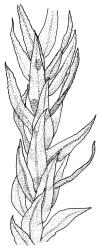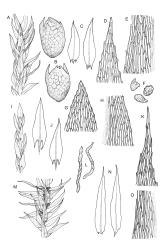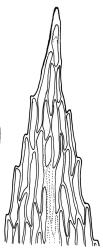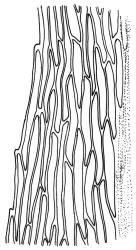Plants yellow-green, medium-sized, dull or weakly lustrous, in small loose tufts, frequently mixed with other species on soil. Stems to 10(–15) mm high, unbranched, red-brown, in cross-section angled, with a distinct central strand and 1(–2) layer(s) of incrassate cortical cells, very sparsely beset with red-brown, papillose rhizoids. Leaves small and distant on lower stem, becoming larger and slightly more crowded distally, erect-spreading to spreading, becoming weakly contorted when dry, lanceolate, slenderly acute, clearly serrulate near apex and serrulate to mid leaf or below, decurrent, plane or loosely recurved (more obviously when dry), (1.0–)1.4–2.0 mm × 0.25–0.35 mm, grading into perichaetial leaves (when present); upper laminal cells linear-rhomboidal or linear-hexagonal to ± vermicular, (75–)100–150 μm × 6–10 μm wide, firm or sometimes thin-walled, not altered at apex, becoming more oblong-rectangular and ± larger towards insertion. Costa ending a few cells below the apex, protruding abaxially, in transverse section with 2–3 guide cells and a group of abaxial stereids. Gemmae in groups of 3 or more in the upper leaf axils, yellow-green to yellow-brown, becoming darker with age, oblong, 200–385 μm long, c. 200 μm broad, with 4–9 triangular-laminate leaf primordia at the apex and lower on the gemma body; cells of the body isodiametric to short-rectangular, to 30 μm long, those of the leaf primordia more elongate.
Dioicous. Perichaetia terminal, overtopped by innovation, with leaves erect, lanceolate (not or scarcely ovate below), c. 2.5–3.0 mm. Perigonia terminal, overtopped by innovation, with differentiated leaves, the outer erect-spreading, longer, more ovate-lanceolate, more recurved, and more pigmented than vegetative, and 2.0–2.5 mm, the innermost leaves shorter. Setae elongate, flexuose, orange, c. 35 mm; capsules seen only slightly immature, pyriform with a neck c. equal to the urn in length, nutant due to curvature of upper setae, probably pale brown at maturity; operculum conic; annulus not seen; exothecial cells irregular (in single dissected capsule); stomata superficial. Exostome as per genus, pale; endostome with a high basal membrane, the cilia not clearly seen (perhaps broken?). Spores c. 15 µm, smooth.
Shaw & Fife 1985, figs 1–8.
This species is unlikely to be collected without its characteristic axillary gemmae and has only once been collected with capsules. It is most likely to be confused with P. camptotrachela, but P. australis has larger and more obviously decurrent leaves, and fewer and larger gemmae per leaf axil. Also, the leaf primordia here are triangular-laminate rather than peg-like, as in P. camptotrachela. The features outlined in the key to species should adequately distinguish it from other congeners.
SI: Nelson (Scarlett Range, Paparoa Range); Canterbury (Mt Cassidy, Temple Basin) Westland (Kelly Range), Otago (near Tahakopa).
Endemic.
Occurring on deeply shaded, sheltered, and friable soil; often beneath overhanging boulders or protected by species of snow tussock (Chionochloa spp.). Many of the confirmed collections are from sites with greywacke bedrock. This species remains known only from the South I., where it ranges from 420 m (near Tahakopa) to 1340 m (Scarlett Range). Pohlia ochii and Ditrichum punctulatum are sometimes associated. Capsules have been seen only in a specimen collected by P.J. Brownsey from near Tahakopa; the sporophyte description presented here is based entirely on this collection (WELT M027583).









